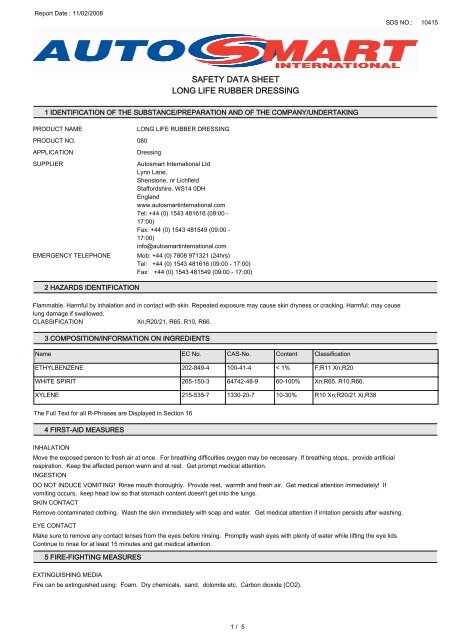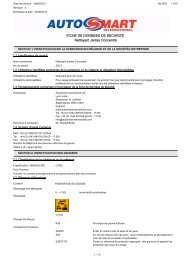SAFETY DATA SHEET LONG LIFE RUBBER DRESSING - Autosmart
SAFETY DATA SHEET LONG LIFE RUBBER DRESSING - Autosmart
SAFETY DATA SHEET LONG LIFE RUBBER DRESSING - Autosmart
Create successful ePaper yourself
Turn your PDF publications into a flip-book with our unique Google optimized e-Paper software.
Report Date : 11/02/2008<br />
<strong>SAFETY</strong> <strong>DATA</strong> <strong>SHEET</strong><br />
<strong>LONG</strong> <strong>LIFE</strong> <strong>RUBBER</strong> <strong>DRESSING</strong><br />
1 IDENTIFICATION OF THE SUBSTANCE/PREPARATION AND OF THE COMPANY/UNDERTAKING<br />
PRODUCT NAME <strong>LONG</strong> <strong>LIFE</strong> <strong>RUBBER</strong> <strong>DRESSING</strong><br />
PRODUCT NO. 080<br />
APPLICATION Dressing<br />
SUPPLIER<br />
<strong>Autosmart</strong> International Ltd<br />
Lynn Lane,<br />
Shenstone, nr Lichfield<br />
Staffordshire. WS14 0DH<br />
England<br />
www.autosmartinternational.com<br />
Tel: +44 (0) 1543 481616 (09:00 -<br />
17:00)<br />
Fax: +44 (0) 1543 481549 (09:00 -<br />
17:00)<br />
info@autosmartinternational.com<br />
EMERGENCY TELEPHONE Mob: +44 (0) 7808 971321 (24hrs)<br />
Tel: +44 (0) 1543 481616 (09:00 - 17:00)<br />
Fax: +44 (0) 1543 481549 (09:00 - 17:00)<br />
2 HAZARDS IDENTIFICATION<br />
Flammable. Harmful by inhalation and in contact with skin. Repeated exposure may cause skin dryness or cracking. Harmful: may cause<br />
lung damage if swallowed.<br />
CLASSIFICATION Xn;R20/21, R65. R10, R66.<br />
3 COMPOSITION/INFORMATION ON INGREDIENTS<br />
Name EC No. CAS-No. Content Classification<br />
ETHYLBENZENE 202-849-4 100-41-4 < 1% F;R11 Xn;R20<br />
WHITE SPIRIT 265-150-3 64742-48-9 60-100% Xn;R65. R10,R66.<br />
XYLENE 215-535-7 1330-20-7 10-30% R10 Xn;R20/21 Xi;R38<br />
The Full Text for all R-Phrases are Displayed in Section 16<br />
4 FIRST-AID MEASURES<br />
INHALATION<br />
Move the exposed person to fresh air at once. For breathing difficulties oxygen may be necessary. If breathing stops, provide artificial<br />
respiration. Keep the affected person warm and at rest. Get prompt medical attention.<br />
INGESTION<br />
DO NOT INDUCE VOMITING! Rinse mouth thoroughly. Provide rest, warmth and fresh air. Get medical attention immediately! If<br />
vomiting occurs, keep head low so that stomach content doesn't get into the lungs.<br />
SKIN CONTACT<br />
Remove contaminated clothing. Wash the skin immediately with soap and water. Get medical attention if irritation persists after washing.<br />
EYE CONTACT<br />
Make sure to remove any contact lenses from the eyes before rinsing. Promptly wash eyes with plenty of water while lifting the eye lids.<br />
Continue to rinse for at least 15 minutes and get medical attention.<br />
5 FIRE-FIGHTING MEASURES<br />
EXTINGUISHING MEDIA<br />
Fire can be extinguished using: Foam. Dry chemicals, sand, dolomite etc. Carbon dioxide (CO2).<br />
1 /<br />
5<br />
SDS NO.: 10415
Report Date : 11/02/2008<br />
SPECIAL FIRE FIGHTING PROCEDURES<br />
<strong>LONG</strong> <strong>LIFE</strong> <strong>RUBBER</strong> <strong>DRESSING</strong><br />
Avoid breathing fire vapours. Cool containers exposed to flames with water until well after the fire is out. Keep run-off water out of sewers<br />
and water sources. Dike for water control.<br />
6 ACCIDENTAL RELEASE MEASURES<br />
PERSONAL PRECAUTIONS<br />
For personal protection, see section 8.<br />
ENVIRONMENTAL PRECAUTIONS<br />
Do not discharge into drains, water courses or onto the ground.<br />
SPILL CLEAN UP METHODS<br />
Extinguish all ignition sources. Avoid sparks, flames, heat and smoking. Ventilate. Absorb in vermiculite, dry sand or earth and place<br />
into containers. Do not contaminate water sources or sewer. Clean-up personnel should use respiratory and/or liquid contact protection.<br />
7 HANDLING AND STORAGE<br />
USAGE PRECAUTIONS<br />
Avoid spilling, skin and eye contact. Keep away from heat, sparks and open flame. Ventilate well, avoid breathing vapours. Use<br />
approved respirator if air contamination is above accepted level. During application and drying, solvent vapours will be emitted.<br />
STORAGE PRECAUTIONS<br />
Flammable/combustible - Keep away from oxidisers, heat and flames. Store in tightly closed original container in a dry, cool and<br />
well-ventilated place. Keep in original container.<br />
STORAGE CLASS<br />
Flammable liquid storage.<br />
Name<br />
8 EXPOSURE CONTROLS/PERSONAL PROTECTION<br />
ETHYLBENZENE<br />
WHITE SPIRIT<br />
XYLENE<br />
INGREDIENT COMMENTS<br />
WEL = Workplace Exposure Limits<br />
PROTECTIVE EQUIPMENT<br />
PROCESS CONDITIONS<br />
Provide eyewash station.<br />
ENGINEERING MEASURES<br />
SDS NO.: 10415<br />
Std LT - ppm LT - mg/m3 ST - ppm ST - mg/m3<br />
WEL 100 ppm(Sk) 441 mg/m3(Sk) 125 ppm(Sk) 552 mg/m3(Sk)<br />
WEL<br />
1000 mg/m3<br />
WEL 50 ppm(Sk) 220 mg/m3(Sk) 100 ppm(Sk) 441 mg/m3(Sk)<br />
No specific ventilation requirements noted, except this product must not be used in a confined space without good ventilation.<br />
RESPIRATORY EQUIPMENT<br />
If ventilation is insufficient, suitable respiratory protection must be provided. Wear mask supplied with: Gas cartridge suitable for organic<br />
substances. In case of inadequate ventilation or risk of inhalation of vapours, use suitable respiratory equipment with combination filter<br />
(type A2/P2).<br />
HAND PROTECTION<br />
Protective gloves should be used if there is a risk of direct contact or splash. Use protective gloves made of: Nitrile. The most suitable<br />
glove must be chosen in consultation with the gloves supplier, who can inform about the breakthrough time of the glove material.<br />
EYE PROTECTION<br />
Wear approved chemical safety goggles where eye exposure is reasonably probable.<br />
OTHER PROTECTION<br />
Provide eyewash station.<br />
HYGIENE MEASURES<br />
DO NOT SMOKE IN WORK AREA! Wash at the end of each work shift and before eating, smoking and using the toilet. Wash promptly<br />
with soap & water if skin becomes contaminated. Promptly remove any clothing that becomes contaminated. Use appropriate skin cream<br />
to prevent drying of skin. When using do not eat, drink or smoke.<br />
2 /<br />
5
Report Date : 11/02/2008<br />
9 PHYSICAL AND CHEMICAL PROPERTIES<br />
APPEARANCE Clear Liquid<br />
COLOUR Yellow<br />
ODOUR Solvent.<br />
<strong>LONG</strong> <strong>LIFE</strong> <strong>RUBBER</strong> <strong>DRESSING</strong><br />
SOLUBILITY Insoluble in water Miscible with Organic solvents.<br />
RELATIVE DENSITY ca 0.815 20 °c VAPOUR DENSITY (air=1) > 1<br />
EVAPORATION RATE > 1 BuAc=1 FLASH POINT (°C) ca 25 CC (Closed cup).<br />
10 STABILITY AND REACTIVITY<br />
STABILITY<br />
Stable under normal temperature conditions.<br />
CONDITIONS TO AVOID<br />
Avoid contact with acids and oxidising substances.<br />
HAZARDOUS DECOMPOSITION PRODUCTS<br />
Fire creates: Toxic gases/vapours/fumes of: Carbon monoxide (CO). Carbon dioxide (CO2).<br />
11 TOXICOLOGICAL INFORMATION<br />
TOXIC DOSE 1 - LD 50 > 4000 mg/kg (oral rat)<br />
GENERAL INFORMATION<br />
Prolonged and repeated contact with solvents over a long period may lead to permanent health problems.<br />
INHALATION<br />
Harmful by inhalation. High concentrations of vapours may irritate respiratory system and lead to headache, fatigue, nausea and vomiting.<br />
INGESTION<br />
Harmful: may cause lung damage if swallowed. Pneumonia may be the result if vomited material containing solvents reaches the lungs.<br />
Harmful: danger of serious damage to health by prolonged exposure if swallowed.<br />
SKIN CONTACT<br />
Harmful in contact with skin. May be absorbed through the skin.<br />
EYE CONTACT<br />
Spray and vapour in the eyes may cause irritation and smarting.<br />
ROUTE OF ENTRY<br />
Inhalation. Skin absorption. Ingestion. Skin and/or eye contact.<br />
TARGET ORGANS<br />
Blood. Central nervous system. Eyes. Gastro-intestinal tract. Kidneys. Liver. Respiratory system, lungs.<br />
MEDICAL SYMPTOMS<br />
Skin contact may cause: Skin irritation. Allergic rash. High concentrations of vapours may irritate respiratory system and lead to<br />
headache, fatigue, nausea and vomiting. Irritation of eyes and mucous membranes. Ingestion may cause: Severe abdominal pain.<br />
Nausea, vomiting. If swallowed, especially in large quantities: Unconsciousness, possibly death.<br />
12 ECOLOGICAL INFORMATION<br />
ECOTOXICITY<br />
No negative effects on the aquatic environment are known.<br />
13 DISPOSAL CONSIDERATIONS<br />
DISPOSAL METHODS<br />
Do not allow runoff to sewer, waterway or ground. Dispose of waste and residues in accordance with local authority requirements.<br />
14 TRANSPORT INFORMATION<br />
3 /<br />
5<br />
SDS NO.: 10415
Report Date : 11/02/2008<br />
<strong>LONG</strong> <strong>LIFE</strong> <strong>RUBBER</strong> <strong>DRESSING</strong><br />
PROPER SHIPPING NAME FLAMMABLE LIQUID N.O.S (White Spirit, Xylene)<br />
UN NO. ROAD 1993<br />
ADR CLASS NO.<br />
3<br />
ADR CLASS Class 3: Flammable liquids. ADR PACK GROUP<br />
III<br />
HAZCHEM CODE 3 [Y]<br />
UN NO. SEA<br />
1993<br />
IMDG CLASS 3<br />
IMDG PAGE NO.<br />
95 (vol 2)<br />
IMDG PACK GR.<br />
15 REGULATORY INFORMATION<br />
LABELLING<br />
III<br />
Harmful<br />
CONTAINS WHITE SPIRIT<br />
RISK PHRASES<br />
<strong>SAFETY</strong> PHRASES<br />
STATUTORY INSTRUMENTS<br />
XYLENE<br />
R10 Flammable.<br />
Chemicals (Hazard Information and Packaging) Regulations.<br />
GUIDANCE NOTES<br />
Workplace Exposure Limits EH40.<br />
16 OTHER INFORMATION<br />
GENERAL INFORMATION<br />
Only trained personnel should use this material.<br />
REVISION DATE 27/09/2007<br />
REV. NO./REPL. SDS GENERATED 1<br />
RISK PHRASES IN FULL<br />
R10<br />
R11<br />
R20<br />
R20/21<br />
R38<br />
R65<br />
R66<br />
Flammable.<br />
R20/21 Harmful by inhalation and in contact with skin.<br />
R66 Repeated exposure may cause skin dryness or cracking.<br />
R65 Harmful: may cause lung damage if swallowed.<br />
S23 Do not breathe vapour/spray.<br />
S36/37 Wear suitable protective clothing and gloves.<br />
S51 Use only in well-ventilated areas.<br />
S60 This material and its container must be disposed of as hazardous waste.<br />
SDS NO.: 10415<br />
S62 If swallowed, do not induce vomiting: seek medical advice immediately and show this<br />
container or label.<br />
Highly flammable.<br />
Harmful by inhalation.<br />
Harmful by inhalation and in contact with skin.<br />
Irritating to skin.<br />
Harmful: may cause lung damage if swallowed.<br />
Repeated exposure may cause skin dryness or cracking.<br />
4 /<br />
5
Report Date : 11/02/2008<br />
<strong>LONG</strong> <strong>LIFE</strong> <strong>RUBBER</strong> <strong>DRESSING</strong><br />
DISCLAIMER<br />
This information relates only to the specific material designated and may not be valid for such material used in combination<br />
with any other materials or in any process. Such information is, to the best of the company's knowledge and belief, accurate<br />
and reliable as of the date indicated. However, no warranty guarantee or representation is made to its accuracy, reliability or<br />
completeness. It is the user's responsibility to satisfy himself as to the suitability of such information for his own particular use.<br />
5 /<br />
5<br />
SDS NO.: 10415





